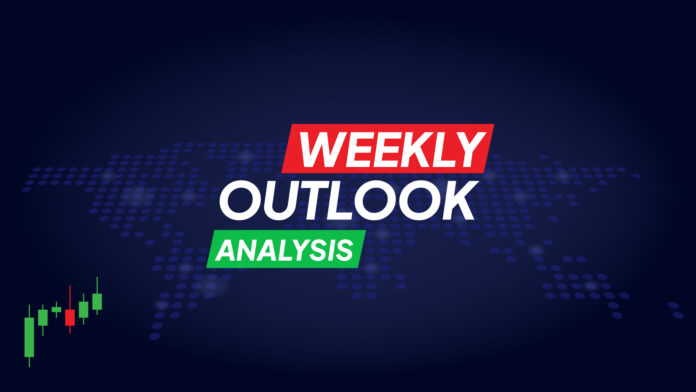The week of June 29–July 4 promises to be pivotal for global markets, with investors watching key economic data and central bank signals amid lingering geopolitical risks. In the U.S., focus will center on core PCE, ISM PMIs, and the jobs report, which could shift expectations for Fed rate cuts, while political tensions over Fed independence weigh on the dollar. In Europe, eurozone inflation and the ECB forum in Sintra will guide the euro’s path, as markets price in fewer cuts. Meanwhile, Asia’s spotlight includes China’s PMIs and Japan’s Tankan survey, which may shape regional rate outlooks.
For additional insights into market movements, explore our educational hub at https://hub.onequity.com, where you can access updated financial data, analysis, and trading resources.
Key Points to Watch Out For
- The ceasefire in the Middle East and the Fed’s maneuvers weigh on the dollar
- The ISM PMIs and nonfarm payrolls will impact bets on a Fed rate cut
- Euro traders will monitor eurozone inflation and the ECB forum
- China’s PMIs, Japan’s Tankan survey, and the Swiss CPI are set to be in the spotlight
Geopolitics and Fed Tensions Weigh on the Dollar
The US dollar weakened against all major currencies last week, initially pressured by President Donald Trump’s announcement of a ceasefire between Israel and Iran. Although there were minor violations shortly after the announcement, the ceasefire held in recent days, triggering a risk-on response across markets. Wall Street stocks rebounded, oil prices fell as supply fears eased, and the dollar—previously the preferred safe-haven asset—lost momentum.
The dollar’s decline was compounded by renewed political tensions between the White House and the Federal Reserve. President Trump criticized Fed Chairman Jerome Powell for not cutting interest rates and, according to the Wall Street Journal, is considering announcing his replacement in September or October. These developments raised concerns about the Fed’s independence and credibility, prompting investors to increase their bets on further rate cuts.
Federal funds futures now point to rate cuts of almost 65 basis points by the end of the year, in line with the two 25 bp reductions suggested by the Fed’s latest dot plot, but also reflecting a more than 50% probability of a third cut. The first rate cut is fully priced in for September, with the probability for July rising to 25%.
Key US Data: ISM, Jobs & Inflation
This week, the focus will be on the ISM manufacturing and services PMIs for June (due on Tuesday, July 1, and Thursday, July 3), along with the nonfarm payrolls report on Thursday, July 3, which has been moved up due to the July 4 holiday. The JOLTS job openings on Tuesday, July 1, and the ADP private employment report on Wednesday, July 2, will also help shape expectations for the Fed’s next moves.
The latest preliminary PMI data from S&P Global exceeded expectations, with a slight decline in the composite index from 53.0 to 52.8, but still well above the forecast of 52.2. It is worth noting that input costs rose in both the manufacturing and services sectors, particularly due to tariffs, and that employment grew at the fastest pace in more than a year.
If ISM and employment data show similar strength, markets could reassess expectations for aggressive interest rate cuts. This could provide short-term support for the US dollar, especially if the labor market continues to show signs of resilience.
However, with some Fed members, such as Waller and Bowman, openly supporting a cut in July—and rumors that Waller could be Powell’s successor in a second Trump term—concerns about political pressure on the Fed could hold back any significant dollar rally.
Eurozone Inflation in Focus
In Europe, the EUR/USD rose to nearly four-year highs as markets adjusted to expectations that the ECB may only implement one more rate cut during this easing cycle. The euro could gain further support if the preliminary eurozone CPI for June, due on Tuesday, July 1, suggests that inflation is stabilizing.
At its last meeting, the ECB cut rates by 25 bps to 2.0%, although the decision was not unanimous. President Lagarde emphasized a data-dependent approach and suggested that the current path of rates puts them in a “good position.” Reuters also reported broad internal consensus to pause rate cuts in July.
Better-than-expected first-quarter GDP growth and a rebound in retail sales in April support this view, but recent PMI and industrial production data leave the door open for further easing later in the year.
Even if inflation picks up slightly from 1.9% year-on-year in May—just below the 2% target—markets are unlikely to significantly change their outlook. Traders could shift their expectations for the ECB’s last rate cut from December to early 2026, which would provide modest support for the euro.
German CPI data will be released on Monday, June 30, coinciding with the start of the ECB’s annual forum in Sintra, Portugal. Lagarde and other officials will speak alongside Fed Chair Powell.
Conclusion
In Asia, China will release its official manufacturing and services PMIs for June, while Japan’s Tankan survey of business confidence will be released this week. Positive surprises in Chinese data could boost the Australian and New Zealand dollars, given their trade exposure to China.
The Tankan report could influence expectations of a possible rate hike by the Bank of Japan at the end of the year, with markets currently split 50/50.
Meanwhile, Switzerland’s CPI for June will be released on Thursday, July 3. Inflation has recently entered negative territory, and although the Swiss National Bank only cut rates by 25 basis points to 0% at its last meeting, markets had priced in a 50 basis point cut. Further deflationary data could increase expectations of additional easing in September and put renewed pressure on the Swiss franc, which remains strong despite global risk appetite.
Trade with confidence—get the latest market insights at OnEquity.com.



